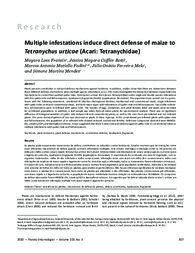Multiple infestations induce direct defense of maize to Tetranychus urticae (Acari: Tetranychidae).
Multiple infestations induce direct defense of maize to Tetranychus urticae (Acari: Tetranychidae).
Autoria: FRANZIN, M. L.; BOTT, J. M. C.; FADINI, M. A. M.; MELO, J. O. F.; MENDES, S. M.
Resumo: Plants present constitutive or induced defense mechanisms against herbivory. In addition, studies show that there are interactions between these different defense mechanisms when multiple species infestations occur. This study investigated the interaction between maize defensive mechanisms to control two-spotted spider mite, Tetranychus urticae Koch (Acari: Tetranychidae) under single and double species infestations with this spider mite and fall armyworm, Spodoptera frugiperda (Smith) (Lepidoptera: Noctuidae). The experiment was carried out in a greenhouse with the following treatments: uninfested Bt (Bacillus thuringiensis Berliner; Bacillaceae) and conventional maize, single infestation with spider mite on Bt and conventional maize, and both maize types with infestations of spider mite and fall armyworm. Two d after infestation, all treatments were re-infested with spider mite. The number of eggs, immatures, and adult females (alive and dead) were recorded for re-infested populations. In addition, a leaf sample was taken from all maize plants for spectrometric analysis. There was no significant difference of biological variables of spider mite between Bt and conventional plants, as well as the ones from pre-infested and non-infested plants. The same chemical pattern of ions was observed on plants in these 4 groups. In the conventional pre-infested plants with spider mite and fall armyworm, the population of re-infested mite showed reduced survival and fertility. Defensive compounds detected were HMBOAGlc, Linoleoyl-GPI, and kaempferol rutinose. It was suggested that there is direct induced defense against spider mite in conventional maize in multiple infestations with spider mite and fall armyworm.
Ano de publicação: 2020
Tipo de publicação: Artigo de periódico
Unidade: Embrapa Milho e Sorgo
Observações
1 - Por padrão são exibidas publicações dos últimos 20 anos. Para encontrar publicações mais antigas, configure o filtro ano de publicação, colocando o ano a partir do qual você deseja encontrar publicações. O filtro está na coluna da esquerda na busca acima.
2 - Para ler algumas publicações da Embrapa (apenas as que estão em formato ePub), é necessário ter, no celular ou computador, um desses softwares gratuitos. Sistemas Android: Google Play Livros; IOS: iBooks; Windows e Linux: software Calibre.
Acesse outras publicações
Acesse a Base de Dados da Pesquisa Agropecuária (BDPA) para consultar o acervo completo das bibliotecas da Embrapa.

